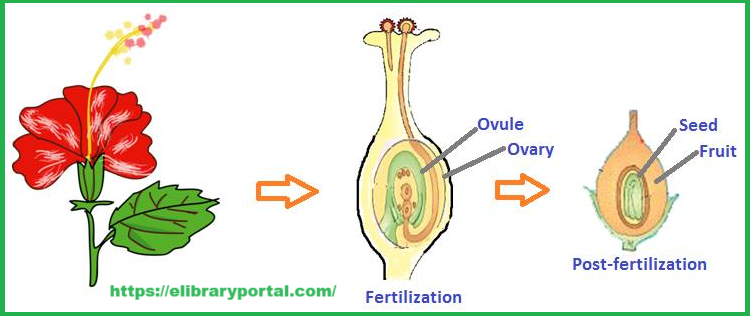Once double fertilization occurs in flowering plants, a series of critical changes take place that lead to the development of seeds and fruits. These post-fertilization events ensure the successful formation of the next generation of plants by transforming the fertilized ovules into seeds and the ovary into a fruit. Understanding these events is key to grasping the reproductive cycle of flowering plants.
In this explanation, we will cover the main post-fertilization structures and events, including seed development, fruit formation, and the maturation process, using simple terms and accompanied by an illustration.
1. Overview of Post-Fertilization Events
After double fertilization, two main products are formed inside the ovule:
- Zygote: Formed by the fusion of one sperm cell with the egg cell. The zygote will develop into the embryo, which eventually grows into a new plant.
- Endosperm: Formed by the fusion of the second sperm cell with the two polar nuclei. The endosperm provides the developing embryo with essential nutrients.
Several significant events follow fertilization, including:
- Development of the zygote into an embryo.
- Development of the ovule into a seed.
- Development of the ovary into a fruit.
2. Zygote Development: Formation of the Embryo
After fertilization, the zygote undergoes multiple rounds of cell division (mitosis) and eventually forms an embryo. The embryo is the young plant that will grow into a new individual after germination. It goes through several stages of development:
- Pro-embryo Stage: The zygote divides into smaller cells, forming the basic structure of the future plant.
- Globular Stage: The embryo takes on a round shape and continues to grow.
- Heart Stage: The embryo starts to form the basic organs, such as the cotyledons (seed leaves), which will be important for early seedling development.
- Torpedo Stage: The embryo elongates and becomes more recognizable as a small plant.
Throughout these stages, the embryo remains inside the developing seed, drawing nutrients from the endosperm.
3. Development of the Seed
The ovule, which houses the embryo, undergoes significant changes and transforms into a seed. A seed is the reproductive unit that allows a plant to disperse and grow into a new individual. Seeds consist of three main parts:
- Embryo: The developing young plant.
- Endosperm: The nutritive tissue that provides food for the embryo.
- Seed Coat (Testa): The outer protective layer that surrounds the seed, keeping the embryo safe until conditions are right for germination.
As the seed matures, it undergoes processes like:
- Desiccation: The seed loses water content, which helps the seed enter a dormant state. This dormancy helps the seed survive unfavorable environmental conditions.
- Hardening of the Seed Coat: The seed coat becomes tough to protect the embryo from physical damage, pathogens, and drying out.
Once the seed is fully mature, it can enter a state of dormancy, waiting for the right conditions (such as temperature and moisture) to germinate and grow into a new plant.
4. Development of the Fruit
While the ovules are transforming into seeds, the surrounding ovary of the flower is also undergoing significant changes. The ovary enlarges and becomes a fruit, which plays a crucial role in protecting the seeds and aiding in their dispersal. The fruit is essentially the mature ovary of the flower, and it varies widely among different plant species in size, shape, and texture.
There are two main types of fruits:
- Fleshy Fruits: These are soft and juicy, such as apples, berries, and tomatoes. They often attract animals, which eat the fruit and help disperse the seeds.
- Dry Fruits: These are hard and dry, such as nuts, grains, and pods. These fruits can disperse seeds by splitting open or being carried by the wind.
In addition to protecting the seeds, fruits also play a role in dispersing seeds. This can happen in various ways:
- By Animals: Animals eat fleshy fruits, and the seeds pass through their digestive systems and are deposited elsewhere.
- By Wind: Lightweight fruits or seeds (such as dandelions or maples) can be carried long distances by the wind.
- By Water: Some fruits, like coconuts, can float on water and be carried to new locations.
5. Seed and Fruit Dispersal
Once seeds are fully mature and the fruit is formed, the next critical step is dispersal. Dispersal is the process by which seeds are spread away from the parent plant, reducing competition and increasing the chances of successful germination in new locations. Plants have evolved various mechanisms for seed dispersal:
- Wind Dispersal: Seeds that are lightweight or have special structures (like wings or parachutes) can be carried by the wind. Examples include dandelions and maple seeds.
- Animal Dispersal: Animals play a crucial role in seed dispersal by consuming fruits and excreting the seeds far from the parent plant. Some seeds have evolved to stick to the fur of animals and are carried to new locations.
- Water Dispersal: Some plants, especially those near water bodies, produce seeds or fruits that can float. Coconuts are an example of water-dispersed fruits, as they can drift in the ocean to reach new islands.
Dispersal ensures that the plant’s offspring have the best chance of finding suitable conditions for growth, far from the shadow of the parent plant.
6. Germination: The Beginning of a New Plant
Once the seed has been dispersed and finds favorable conditions, the next stage is germination. Germination is the process by which a seed emerges from dormancy and begins to grow into a seedling. The right conditions for germination typically include:
- Moisture: Water is needed to activate the enzymes in the seed that promote growth.
- Temperature: The right temperature range is necessary for the seed to break dormancy and start growing.
- Oxygen: Seeds need oxygen for cellular respiration, which provides energy for growth.
When these conditions are met, the seed absorbs water, and the embryo begins to grow. The seed coat breaks open, and the first structures to emerge are the radicle (the young root) and the shoot (the young stem and leaves). This marks the beginning of the seedling’s life cycle.
7. Summary of Post-Fertilization Events
- Fertilization: Two sperm cells fertilize the egg and polar nuclei, leading to the formation of the zygote (which becomes the embryo) and the endosperm (which nourishes the embryo).
- Embryo Development: The zygote develops into a multi-cellular embryo within the seed.
- Seed Formation: The ovule transforms into a seed, which contains the embryo, endosperm, and a protective seed coat.
- Fruit Development: The ovary becomes a fruit that protects the seeds and helps in their dispersal.
- Seed Dispersal: Seeds are spread by various means (wind, animals, water) to new locations for growth.
- Germination: When conditions are right, the seed germinates, and the embryo grows into a new plant.
See in Fig.

Here are 10 key Questions and Answers about Post-Fertilization: Structures and Events in Flowering Plants:
1. What is the primary outcome of the fertilization process in flowering plants?
Answer:
The primary outcome of fertilization in flowering plants is the formation of a zygote, which will develop into an embryo, and the formation of endosperm. The zygote forms when the sperm cell fuses with the egg cell, while the endosperm is formed by the fusion of the second sperm cell with two polar nuclei. This marks the beginning of seed formation.
2. What are the main structures formed after fertilization in a flowering plant?
Answer:
After fertilization, the main structures formed are:
- Embryo: The developing plant inside the seed, which arises from the zygote.
- Endosperm: A tissue that provides nutrition to the developing embryo.
- Seed Coat (Testa): A protective outer layer that forms around the embryo and endosperm.
- Fruit: The mature ovary that protects the seeds and aids in their dispersal.
3. How does the zygote develop into an embryo?
Answer:
The zygote undergoes multiple rounds of cell division (mitosis) to form a multicellular structure called the embryo. The embryo goes through several stages of development:
- Pro-embryo stage
- Globular stage
- Heart stage
- Torpedo stage As the embryo develops, it forms the basic structures of the future plant, such as cotyledons (seed leaves), and the shoot and root systems.
4. What happens to the ovule after fertilization?
Answer:
After fertilization, the ovule undergoes a transformation to become a seed. The embryo develops within the ovule, and the endosperm forms to nourish the embryo. The outer layers of the ovule harden to form the seed coat, which protects the developing embryo and endosperm. The seed eventually matures and prepares for dispersal and germination.
5. How does the ovary change after fertilization?
Answer:
After fertilization, the ovary enlarges and transforms into a fruit. The fruit serves two main functions:
- Protection of the seeds: It encloses and safeguards the developing seeds from damage and environmental threats.
- Aid in seed dispersal: Fruits help in the dispersal of seeds through various mechanisms, such as being eaten by animals, carried by the wind, or floating on water.
6. What are the main types of fruits formed after fertilization?
Answer:
Fruits are classified into two main types:
- Fleshy Fruits: These fruits have a soft and juicy texture, such as apples, berries, and tomatoes. They often attract animals that help in dispersing the seeds.
- Dry Fruits: These fruits are hard and dry, such as nuts, grains, and pods. They may split open to release the seeds or rely on other mechanisms like wind dispersal.
7. What role does the endosperm play in seed development?
Answer:
The endosperm provides the developing embryo with essential nutrients, such as carbohydrates, proteins, and fats, to support its growth until it becomes self-sufficient during germination. In some plants, the endosperm is consumed entirely by the growing embryo before seed maturation, while in others (such as grains), it remains in the seed to nourish the plant during germination.
8. What is seed dispersal, and why is it important?
Answer:
Seed dispersal is the process by which seeds are spread away from the parent plant to new locations. It is important because it:
- Reduces competition for resources between the parent plant and offspring.
- Increases the chances of seeds finding favorable conditions for germination and growth.
- Allows plants to colonize new areas and expand their range.
9. What are the main methods of seed dispersal?
Answer:
Seeds can be dispersed through various mechanisms:
- Wind Dispersal: Seeds that are lightweight or have wing-like structures (e.g., dandelions, maple seeds) are carried by the wind.
- Animal Dispersal: Animals consume fruits and excrete the seeds elsewhere, or seeds can stick to their fur (e.g., berries, nuts).
- Water Dispersal: Seeds or fruits that can float are carried by water (e.g., coconuts).
- Mechanical Dispersal: Some plants have fruits that forcefully eject seeds when ripe (e.g., pea pods).
10. What happens during seed germination?
Answer:
Germination is the process by which a seed breaks dormancy and starts to grow into a new plant. The conditions necessary for germination include:
- Water: Hydrates the seed and activates enzymes for growth.
- Oxygen: Needed for cellular respiration to provide energy.
- Temperature: Suitable temperatures vary by species, but they help break dormancy and trigger growth.
During germination, the seed absorbs water, the seed coat splits open, and the embryonic root (radicle) emerges, followed by the shoot, which grows upward toward the light.






